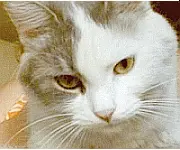|
FELINE DIABETES SYMPTOMS
When glucose levels become abnormally high, the glucose is filtered out by the kidney and eliminated through urine. When kitty eliminates the glucose, he eliminates water. The high glucose causes kitty to urinate more often, meaning that kitty loses more water than normal. Kitty must then make up for this by drinking more water. Kitty's increased need for urination may at times force your feline friend to go 'outside the box'. Watch for this as a possible symptom. Kitties do not eat when they do not feel good. This, in conjunction with kitty's inability to burn through the calories he eats means that kitty uses up fat for energy. This in turn causes weight loss. The loss in weight, may affect muscle mass. This makes walking more difficult. The less energy and activity kitty has the more depressed he becomes. This results from kitty using his fat & muscle for energy. This causes the development of waste products in kitty's blood. These cause kitty to become nauseated and induces vomiting in the process. TYPES OF DIABETES in CatsAffects 50-75% of diabetic cats. Kitties with Type I diabetes are often thin, and can develop serious, life-threatening conditions due to the body's problems in burning the right type of calories. Kitties with Type I Diabetes are thin and require insulin therapy. Affects 25-50% of cats with diabetes. Type II Diabetes results in a delay in insulin secretion as the blood glucose increases. This is followed by excess insulin secretion. Fortunately, in this type of diabetes, kitty can survive without additional insulin. Kitties with Type II Diabetes are often overweight and are treated through specialized diets(#Ad) and medicine to reduce blood glucose levels.I hope this has been helpful. Simba DETECT FELINE DIABETES
Diabetes is diagnosed when tests show persistently high glucose
levels in the blood and urine (it is important to test urine,
because stressed cats produce more glucose in the blood and the
vet visit is stressful to kitty). Tests may also reveal,
increased liver enzymes along with a high cholesterol count. The
levels of potassium, sodium and phosphorous may also be below
normal.
TREATMENT FOR CATS WITH DIABETES
What you feed your cat is very important. Many experts believe that like humans, cats with diabetes respond well to low-carbohydrate diets. In general there are three treatment options:
Cat with Diabetes
Hi Simba,
I found kittencare.com while searching for care information for two, 5-week-old orphans I am adopting this week...it is a great site! I am writing is to share an experience I had Recently with my 3-year-old spayed female cat. She was the picture of health, over ten pounds and with a beautiful coat. She had had regular veterinary care, and there was no indication of a health problem, when she began to spray inside the house. The spraying became a chronic problem. She sprayed many times a day, ruining the carpet, hardwood floors, and furniture. I had never seen a female cat spray. She would back up to the sofa like a tomcat. My vet was convinced it was a behavioral problem. Quite suddenly and dramatically her health declined. She had just had her annual check up and vaccinations the month before. After examining her my vet was baffled, and I finally convinced him to test her urine. Her glucose level was dangerously high, and subsequent blood tests revealed that diabetes had already caused internal organ damage. I had lost an elderly cat to diabetes just three years before but I did not recognize the symptoms.I think my vet learned a lesson, and it might be worth mentioning on your site that people should never assume their cat's spraying is behavioral until they have completely ruled out a physical cause. Pat S Dear Pat, Sorry to hear of your loss. Thank you for your letter. Readers - Take note, kitty may be trying to tell you something. Simba |
